Just Ducky
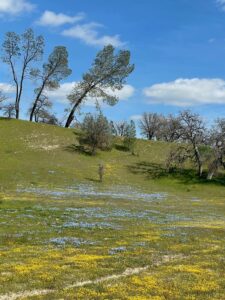
Pinus Sabiniana along the road to Carrizo Plain. My father did his doctoral thesis on this tree species, which used to be called the “Digger Pine,” because the Native Americans gathered around them to collect the rich, flavorful seeds. Dad cautioned me that it would be best to call the plant by its scientific name, or at least one of its other nicknames, like “Ghost Pine,” “Gray Pine,” or “Bull Pine,” so as to avoid offending people. Waking up to the more painful parts of our history, like the genocide of Native Americans, is NOT the problem. “Woke” is no joke. The politicians who would seek to keep knowledge about slavery or genocide under wraps are not patriotic, just too scared to peek out from behind the flag.
One of the things some Yankees found barbarous about the Indians they met in the “new” lands they occupied, was that, for indigenous residents, cooking up some grub might mean cooking up some grubs. Grubs are beetle larvae. Scientists can tell you that, as a food, grubs are high in antioxidants, essential amino acids, and vitamins, and the Indigenous cooks could give you some recipes, but most contemporary consumers in the US would say that grubs are nauseating, like maggots. Scientists and Indians could tell you that maggots are good food too, but even the word “maggot” is enough to reliably summon forth a host of “food issues” for many folks.
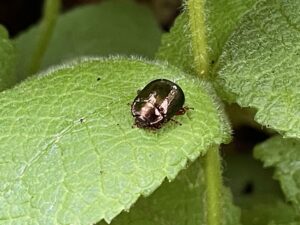
Here’a a cool, metallic, silver Beetle I encountered today in the Apple mint. DId you know that before they were “The Beatles” John, Paul, and George were briefly “The SIlver Beatles?”
The American pioneers saw the locals they were displacing using sharp sticks to scratch in the soil and unearth such grubs, and they called them “diggers,” using the term as a dehumanizing pejorative, like the “n word,” but with a “d.”
Over a hundred years later, in 1966, community-minded anarchists in The San Francisco Mime Troupe began to toy with the idea of leaving the urban psychedelia of Haight-Ashbury behind and going “back to the land.” They called themselves The Diggers.
These modern, countercultural “diggers” took inspiration, in part, from a group of 17th Century agrarian socialists in England who sought to create a subsistence farming movement on Common Lands and who had been called “Diggers” by both friend and foe. The new 60s “Diggers” also looked to California’s First Peoples as role models for a renewed ecological consciousness. The biggest food issue that the Diggers could see was the problematic role of Capitalism in the food system.
The old pejorative term “Digger” had a resonance for these activist hippies. They appropriated the old anti-Native American racist slur to define their own identity and contrast themselves with the corporate war machine. Can you dig it?
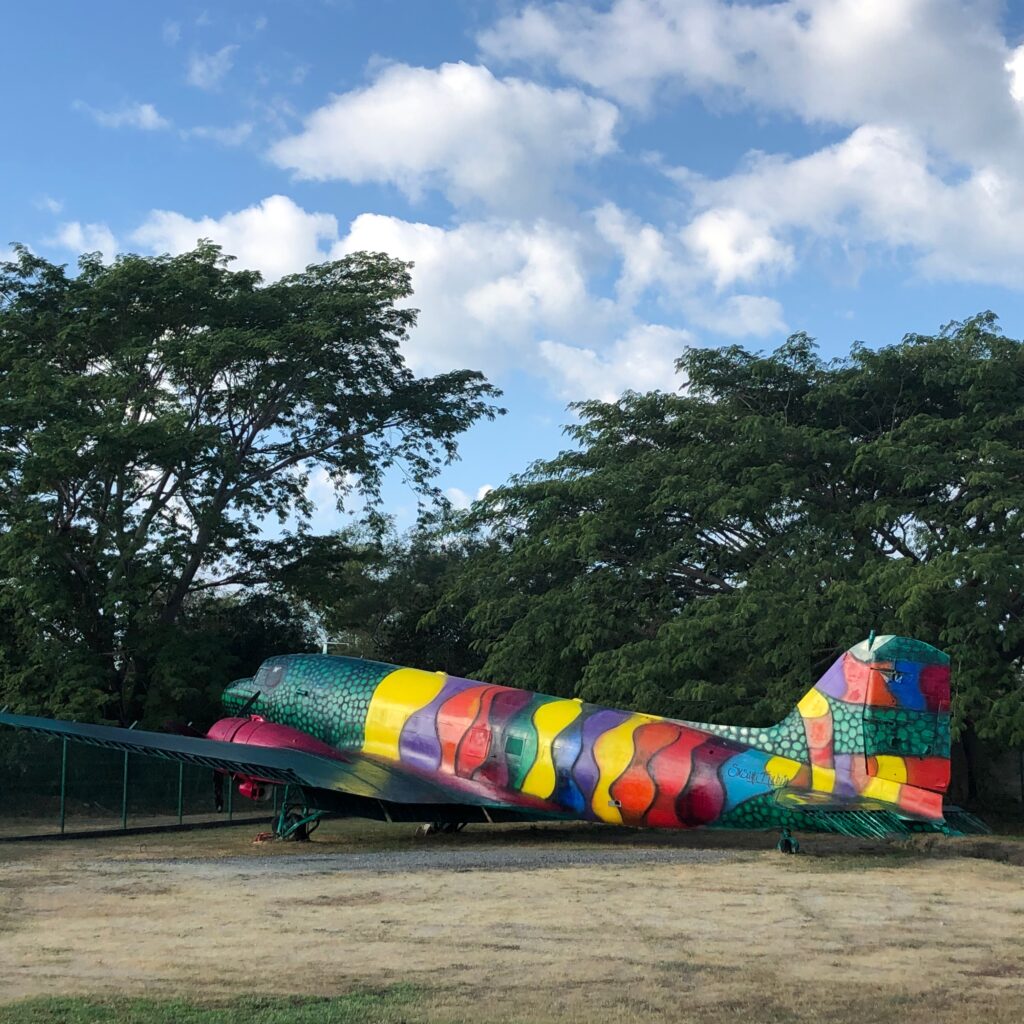
The Haight wasn’t the only psychedelic neighborhood. Oaxaca seems to have an aptitude for the surreal & psychedelic. We took a trip there and saw this old airplane at the Huatulco airport. Strap on those seatbelts; it’s going to be a colorful flight!
Grubs have always been too much of a challenge for me to eat, but that’s my social conditioning speaking, not my rational brain. There are many smart people advancing the idea that human consumption of insects, larval or otherwise, could be key to eliminating world hunger.
Even if you don’t want to eat grubs like popcorn, one after another, insects may become part of our food chain. The world’s resources of marine creatures have been devastated, for example, by overfishing— and a lot of fish are ground up to make organic fertilizers.
If insects, like flies and maggots, were raised on a vast scale to be processed into fertilizers, utilizing human food waste as a growing medium, we could reduce our dependence on already depleted fisheries even as we reduce the amount of waste going into our dumps. We could reduce the amount of methane escaping from the dumps and contaminating the atmosphere. Also, protein powders derived from farmed insects could be valuable as food additives for processed foods like breakfast cereals, by increasing the food value of these products even as we disguise the existentially-uncomfortable source of their nutrition.
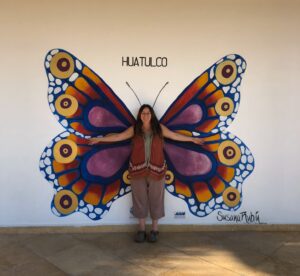
A Oaxacan moth – or is it a butterfly? – at the Huatulco Airport. Corn ear-worms are the larvae of the Corn moth, and every Oaxacan farmers market will have someone making them into tacos.
A Triqi Indian labor crew from Oaxaca once schooled me in this matter of eating insects.
We were picking some fresh corn for the farmers market, and I asked three of the crew to pluck the nasty-looking corn ear-worms out of the corn ears so that our sensitive customers would only see the silky yellow ears. Corn ear-worms are the larval form of a moth. I was surprised to see the guys carefully collecting the ear-worms into a clean bucket.
“You don’t have to treat them like treasures,” I said.
They laughed at me. For lunch, they boiled some salted water over a camp stove and blanched their catch of plump worms for a few seconds. They removed the pot from the flame, drained off the excess water, and quickly pan-fried the worms to make them crispy. They folded the fried worms into warm corn tortillas, added a splash of tomatillo sauce, some chopped cilantro and onion, and finished off with a squeeze of lemon. “Voila!”— I was presented with a plate of traditional Oaxacan tacos.
“These are always popular during the corn harvest,” they told me.
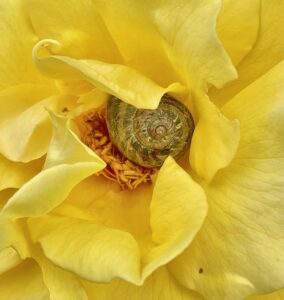
A rose fed escargot eating out the heart of a rose as it fattens itself for the farm-to-white-tablecloth crowd.
But Native Americans don’t have a monopoly on eating agricultural pests. Example Deux: the French. One environmentally sophisticated response to an infestation of snails is to gather them from the field, cleanse and fatten them on cornmeal, and cook them up as “escargot.” Only an ancient, refined, and ironic culture can think to control pests by drowning them in butter, smothering them in chopped garlic and parsley, and serving them up to be eaten, with their minced and marinated flesh re-cupped into their very own shells and plated on china, right next to a serving of the vegetable that they once molested.
I could eat a length of garden hose if it was cooked with enough butter, parsley, and garlic, but eating agricultural pests as a control measure is not a solution that everyone can swallow. Observant Jews, for example, won’t eat mollusks, because they’re not kosher. Snails are mollusks, but so are their cousins, the slugs. Even the French won’t eat slugs.
It was taken as gospel among the hippie homesteaders I grew up around in the Bay Area, that ducks will eat all the slugs and snails they can find in a garden. I once worked on a farm with a patch of artichokes that was being obliterated by a snail plague. You could walk down one row with a 5-gallon bucket and strip enough fat, round snails to fill it.
I couldn’t stand to see a vast mess of snails destroy our crops. I had a vision of fattening a flock of ducks off of all the slugs and snails, and then selling the ducks to French restaurants for duck l’orange. It was a “kill two birds with one stone” idea, except that I’d be killing a million slugs and snails, plus any number of fattened birds.
I left the farm, drove around the shores of Bolinas Lagoon to Highway One, and north to Point Reyes Station, where I purchased two happy ducks for fifteen dollars: a drake and a hen.
Before she would release the birds into my custody, the duck dealer, a middle-aged woman who spoke of the ducks as her “feather children,” made me promise on all that was holy that I would not eat them.
I promised; so much for my savory, profitable, and elegant “circle of life” pesticide program!
I could’ve raised the ducks, slaughtered them, and sold them to somebody else, monetizing their ducky lives for a quick profit without breaking a promise. But lying seemed like bad karma. Plus, the young duck couple with their cute white plumage and iconic orange bills, their ridiculous quacking and their incessant butt-wiggling, endeared themselves to me. If the drive back home had been much longer, I might’ve ended up with two feather children myself.
Back at the farm I took the two white puddle ducks to the artichoke patch. I sat back to watch my ecologically-correct mollusk control program take off. The ducks stepped out of the confines of the carton they’d traveled in, took one look at the snail-infested artichoke patch, eyed the bright waters of the Bolinas Lagoon shimmering in the distance, and flew to freedom.
The duck lady wasn’t happy to see my return. She feared for the safety of her two backyard ducks once they had to face the cruelty of nature. Would the wild mallards on the lagoon welcome them into their flock? Or would the two cute white ducks be shunned as albino freaks and left to fend for themselves, surrounded by bald eagles, hawks, owls, coyotes, foxes, dogs, bobcats, mountain lions, skunks, raccoons, and snakes?
In the end she agreed to sell me two more birds. I prevailed upon her to teach me how to clip their wings. “We wouldn’t want them to fly off and get eaten by bobcats in the wild, would we?”
When I got back to the ranch I locked the two ducks up in a large, empty chicken coop. The ducks made such a cute couple, I caught myself counting my ducklings before my hen even got laid. We would probably have to hire a duck herder just to guide our flock from field to field!
I gathered up a five-gallon bucket full of snails, and dumped it into the coop so my new feathered helpers wouldn’t get hungry. I was hungry too, after my morning’s work, so I went to my cabin for lunch.
When I returned a half-hour later, I was surprised to see the ducks cowering in the corner of the cage, surrounded by a slobbering mob of snails.
Two ducks, thirty dollars, and a million snails added up to exactly zero. Apparently these ducks, like so many of us, had “food issues.”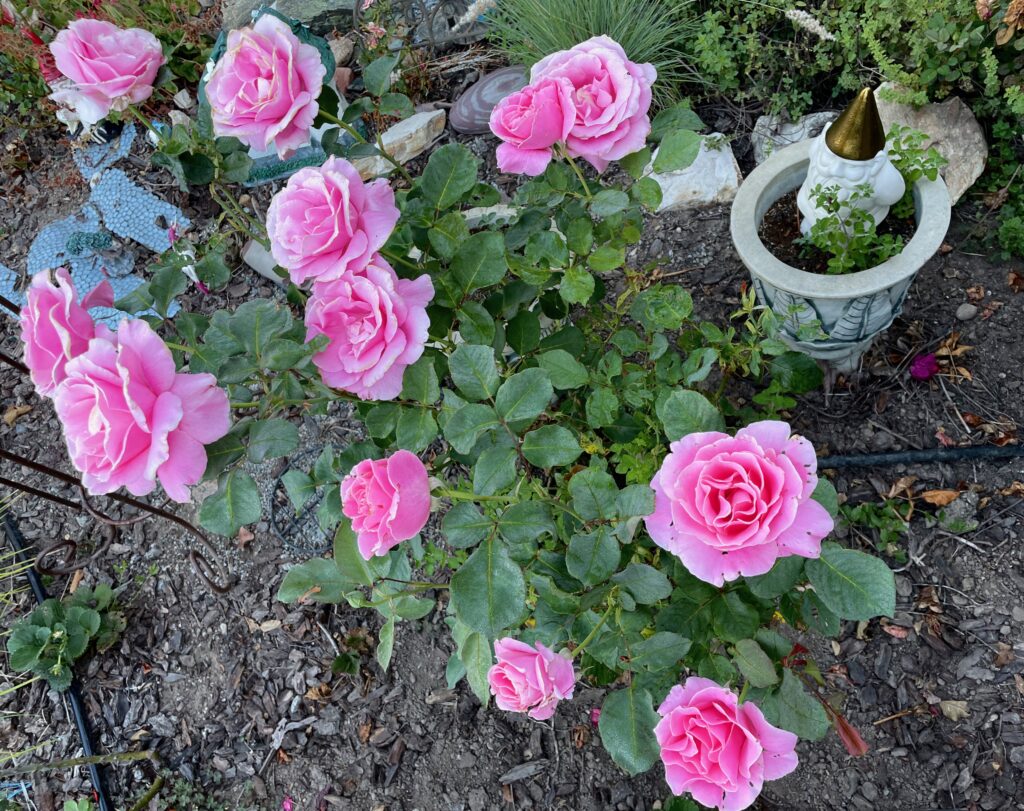

The Grateful Dead have evolved into a myriad of forms over the year, including this iteration, Dead & Company. I took this picture of their iconic Dead Head logo in Chula Vista
Our lavender labyrinth and flower gardens are a labor of love and we can always a little help, especially with weeding in the lavender or dead heading in the roses. “Dead-headers” don’t have to be Dead Heads. Check this link if you’re interested in volunteering as a “Garden Gnome.” https://www.mariquita.com/friends-of-ladybugs-labyrinth/
© 2023 Essay by Andy Griffin


